Business
Evergrande: Chinese property giant delisted after spectacular fall
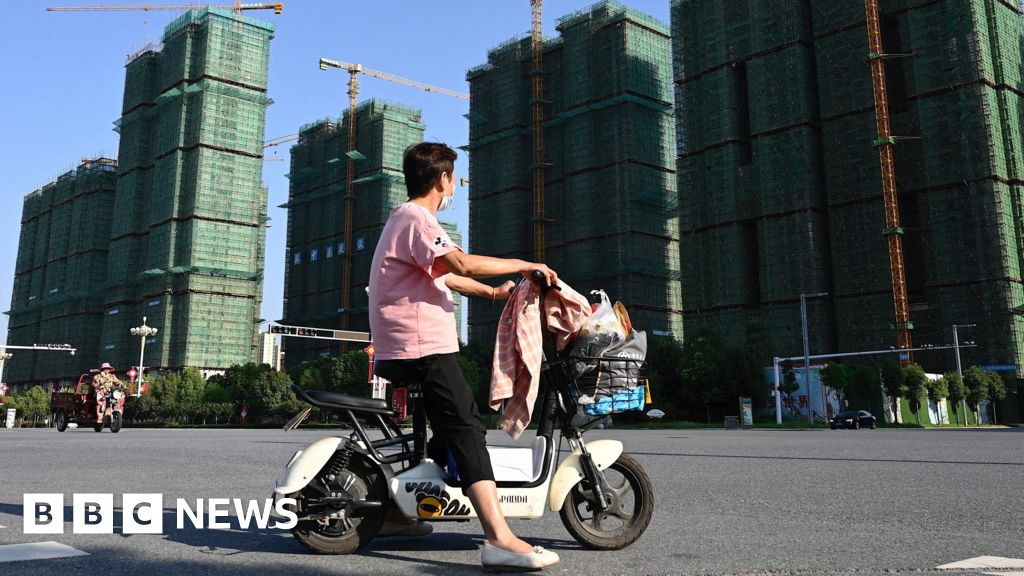
Business reporter, BBC News
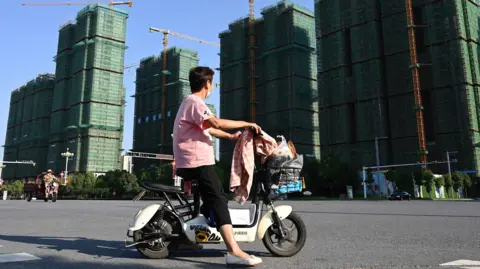 AFP via Getty Images
AFP via Getty ImagesChinese property giant Evergrande’s shares were taken off the Hong Kong stock market on Monday after more than a decade and a half of trading.
It marks a grim milestone for what was once China’s biggest real estate firm, with a stock market valuation of more than $50bn (£37.1bn). That was before its spectacular collapse under the weight of the huge debts that had powered its meteoric rise.
Experts say the delisting was both inevitable and final.
“Once delisted, there is no coming back,” says Dan Wang, China director at political risk consultancy Eurasia Group.
Evergrande is now best-known for its part in a crisis that has for years dragged on the world’s second-largest economy.
What happened to Evergrande?
Just a few years ago Evergrande Group was a shining example of China’s economic miracle.
Its founder and chairman Hui Ka Yan rose from humble beginnings in rural China to top the Forbes list of Asia’s wealthiest people in 2017.
His fortune has since plummeted from an estimated $45bn in 2017 to less than a billion, his fall from grace as extraordinary as his company’s.
In March 2024, Mr Hui was fined $6.5m and banned from China’s capital market for life for his company overstating its revenue by $78bn.
Liquidators are also exploring whether they can recover cash for creditors from Mr Hui’s personal property.
At the time of its collapse, Evergrande had some 1,300 projects under development in 280 cities across China.
The sprawling empire also included an electric carmaker and China’s most successful football team, Guangzhou FC, which was kicked out of the football league earlier this year after failing to pay off enough of its debts.
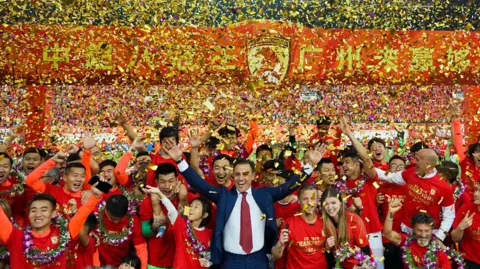 AFP via Getty Images
AFP via Getty ImagesEvergrande was built on $300bn (£222bn) of borrowed money, earning it the unenviable title of the world’s most indebted property developer.
The rot set in after Beijing brought in new rules in 2020 to control the amount big developers could borrow.
The new measures led Evergrande to offer its properties at major discounts to ensure money was coming in to keep the business afloat.
Struggling to meet interest payments, the firm soon defaulted on some of its overseas debts.
After years of legal wrangling, the Hong Kong High Court ordered the company to be wound up in January 2024.
Evergrande’s shares had been under threat of delisting ever since because they were suspended from trading after the court order.
By that point the crisis engulfing the firm had wiped more than 99% from its stock market valuation.
The liquidation order came after the company was unable to offer a workable plan to shed billions of dollars of overseas liabilities.
Earlier this month, liquidators revealed that Evergrande’s debts currently stand at $45bn and that it had so far sold just $255m of assets. They also said they believe a complete overhaul of the business “will prove out of reach”.
The “delisting now is surely symbolic but it’s such a milestone,” Ms Wang says.
All that remains is which creditors are paid and how much they can get in the bankruptcy process, says Professor Shitong Qiao from Duke University.
The next liquidation hearing is due to take place in September.
How was China’s economy impacted?
China is facing a number of major problems, including US President Donald Trump’s tariffs, high local government debt, weak consumer spending, unemployment and an ageing population.
But experts say Evergrande’s collapse, along with the serious problems faced by other developers, has hit the country hardest.
“The property slump has been the biggest drag on the economy, and the ultimate reason why consumption is suppressed,” Ms Wang says.
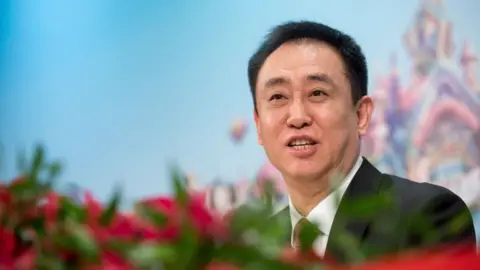 Getty Images
Getty ImagesThis is particularly problematic as the industry accounted for about a third of the Chinese economy and was a major source of income for local governments.
“I don’t think China has found a viable alternative to support its economy at a similar scale,” Professor Qiao says.
The property crisis has led to “massive layoffs” by heavily-indebted developers, Jackson Chan from financial markets research platform Bondsupermart says.
And many real estate industry employees that kept their jobs have seen big pay cuts, he adds.
The crisis is also having a major impact on many households as they tend to put their savings into property.
With housing prices dropping by at least 30%, many Chinese families have seen their savings fall in value, says Alicia Garcia-Herrero, chief economist for Asia Pacific at French bank Natixis.
This means they are less likely to spend and invest, she adds.
In response, Beijing has announced a raft of initiatives aimed at reviving the housing market, stimulating consumer spending and boosting the wider economy.
They range from measures to help new home owners and support the stock market to incentives to buy electric cars and household goods.
Despite the hundreds of billions of dollars Beijing has poured into the economy, China’s once-blistering growth has eased to “around 5%”.
While most Western countries would be more than happy with that, it’s slow for a country that saw growth of more than 10% a year as recently as 2010.
Is the property crisis over yet?
In short, probably not.
Even as Evergrande continues to grab headlines, several other Chinese property firms are still facing major challenges.
Earlier this month, China South City Holdings was handed a winding up order by Hong Kong’s High Court, making it the biggest developer to be forced into liquidation since Evergrande.
Meanwhile, rival real estate giant Country Garden is still trying to secure a deal with its creditors to write off more than $14bn of outstanding foreign debt.
After a series of postponements, its next High Court liquidation hearing in Hong Kong is due to take place in January 2026.
“The whole property sector has been in trouble. More Chinese property firms will collapse,” Professor Qiao says.
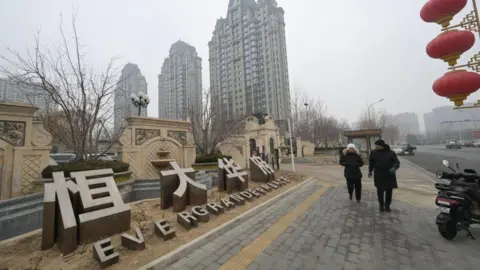 AFP via Getty Images
AFP via Getty ImagesWhile the Chinese government has taken a number of measures to help shore up the property market and support the economy as a whole it has not swooped in to directly bail out developers.
Mr Chan says these initiatives seem to be having a positive impact on the property market: “We think the bottom [has been reached] and it should be in a slow recovery. However, we probably don’t expect the recovery to be very strong.”
Wall Street investment giant Goldman Sachs warned in June that property prices in China will continue to fall until 2027.
Ms Wang agrees, and estimates that China’s stricken property market will “hit the bottom” in around two years when demand finally catches up with supply.
But Ms Garcia-Herrero puts it in starker terms: “there is no real light at the end of the tunnel.”
Beijing has sent a “clear message on its intention of not bailing out the housing sector,” Ms Wang adds.
The Chinese government has been careful to avoid the kind of measures that could encourage further risky behaviour by an already heavily indebted industry.
And while in the boom times, the property market was a key driver of China’s economic growth, the ruling Communist Party’s priorities now lie elsewhere.
President Xi Jinping is more focussed on high-tech industries like renewable energy, electric cars and robotics.
As Ms Wang puts it, “China is in a deep transition to a new age of development.”
Business
South Korea: Online retail giant Coupang hit by massive data leak

Osmond ChiaBusiness reporter
 Getty Images
Getty ImagesSouth Korea’s largest online retailer, Coupang, has apologised for a massive data breach potentially involving nearly 34 million local customer accounts.
The country’s internet authority said that it is investigating the breach and that details from the millions of accounts have likely been exposed.
Coupang is often described as South Korea’s equivalent of Amazon.com. The breach marks the latest in a series of data leaks at major firms in the country, including its telecommunications giant, SK Telecom.
Coupang told the BBC it became aware of the unauthorised access of personal data of about 4,500 customer accounts on 18 November and immediately reported it to the authorities.
But later checks found that some 33.7 million customer accounts – all in South Korea – were likely exposed, said Coupang, adding that the breach is believed to have begun as early as June through a server based overseas.
The exposed data is limited to name, email address, phone number, shipping address and some order histories, Coupang said.
No credit card information or login credentials were leaked. Those details remain securely protected and no action is required from Coupang users at this point, the firm added.
The number of accounts affected by the incident represents more than half of South Korea’s roughly-52 million population.
Coupang, which is founded in South Korea and headquartered in the US, said recently that it had nearly 25 million active users.
Coupang apologised to its customers and warned them to stay alert to scams impersonating the company.
The firm did not give details on who is behind the breach.
South Korean media outlets reported on Sunday that a former Coupang employee from China was suspected of being behind the breach.
The authorities are assessing the scale of the breach as well as whether Coupang had broken any data protection safety rules, South Korea’s Ministry of Science and ICT said in a statement.
“As the breach involves the contact details and addresses of a large number of citizens, the Commission plans to conduct a swift investigation and impose strict sanctions if it finds a violation of the duty to implement safety measures under the Protection Act.”
The incident marks the latest in a series of breaches affecting major South Korean companies this year, despite the country’s reputation for stringent data privacy rules.
SK Telecom, South Korea’s largest mobile operator, was fined nearly $100m (£76m) over a data breach involving more than 20 million subscribers.
In September, Lotte Cards also said the data of nearly three million customers was leaked after a cyber-attack on the credit card firm.
Business
Pakistan’s crisis differs from world | The Express Tribune
1729471601-0/image-(8)1729471601-0-640x480.webp)
Multiple elite clusters capture system as each extracts benefits in different ways
Pakistan’s ruling elite reinforces a blind nationalism, promoting the belief that the country does not need to learn from developed or emerging economies, as this serves their interests. PHOTO: FILE
KARACHI:
Elite capture is hardly a unique Pakistani phenomenon. Across developing economies – from Latin America to Sub-Saharan Africa and parts of South Asia – political and economic systems are often influenced, shaped, or quietly commandeered by narrow interest groups.
However, the latest IMF analysis of Pakistan’s political economy highlights a deeper, more entrenched strain of elite capture; one that is broader in composition, more durable in structure, and more corrosive in its fiscal consequences than what is commonly observed elsewhere. This difference matters because it shapes why repeated reform cycles have failed, why tax bases remain narrow, and why the state repeatedly slips back into crisis despite bailouts, stabilisation efforts, and policy resets.
Globally, elite capture typically operates through predictable channels: regulatory manipulation, favourable credit allocation, public-sector appointments, or preferential access to state contracts. In most emerging economies, these practices tend to be dominated by one or two elite blocs; often oligarchic business families or entrenched political networks.
In contrast, Pakistan’s system is not captured by a single group but by multiple competing elite clusters – military, political dynasties, large landholders, protected industrial lobbies, and urban commercial networks; each extracting benefits in different forms. Instead of acting as a unified oligarchic class, these groups engage in a form of competitive extraction, amplifying inefficiencies and leaving the state structurally weak.
The IMF’s identification of this fragmentation is crucial. Unlike countries where the dominant elite at least maintains a degree of policy coherence, such as Vietnam’s party-led model or Turkiye’s centralised political-business nexus, Pakistan’s fragmentation results in incoherent, stop-start economic governance, with every reform initiative caught in the crossfire of competing privileges.
For example, tax exemptions continue to favour both agricultural landholders and protected sectors despite broad consensus on the inefficiencies they generate. Meanwhile, state-owned enterprises continue to drain the budget due to overlapping political and bureaucratic interests that resist restructuring. These dynamics create a fiscal environment where adjustment becomes politically costly and therefore systematically delayed.
Another distinguishing characteristic is the fiscal footprint of elite capture in Pakistan. While elite influence is global, its measurable impact on Pakistan’s budget is unusually pronounced. Regressive tax structures, preferential energy tariffs, subsidised credit lines for favoured industries, and the persistent shielding of large informal commercial segments combine to erode the state’s revenue base.
The result is dependency on external financing and an inability to build buffers. Where other developing economies have expanded domestic taxation after crises, like Indonesia after the Asian financial crisis, Pakistan’s tax-to-GDP ratio has stagnated or deteriorated, repeatedly offset by politically negotiated exemptions.
Moreover, unlike countries where elite capture operates primarily through economic levers, Pakistan’s structure is intensely politico-establishment in design. This tri-layer configuration creates an institutional rigidity that is difficult to unwind. The civil-military imbalance limits parliamentary oversight of fiscal decisions, political fragmentation obstructs legislative reform, and bureaucratic inertia prevents implementation, even when policies are designed effectively.
In many ways, Pakistan’s challenge is not just elite capture; it is elite entanglement, where power is diffused, yet collectively resistant to change. Given these distinctions, the solutions cannot simply mimic generic reform templates applied in other developing economies. Pakistan requires a sequenced, politically aware reform agenda that aligns incentives rather than assuming an unrealistic national consensus.
First, broadening the tax base must be anchored in institutional credibility rather than coercion. The state has historically attempted forced compliance but has not invested in digitalisation, transparent tax administration, and trusted grievance mechanisms. Countries like Rwanda and Georgia demonstrate that tax reforms succeed only when the system is depersonalised and automated. Pakistan’s current reforms must similarly prioritise structural modernisation over episodic revenue drives.
Second, rationalising subsidies and preferential tariffs requires a political bargain that recognises the diversity of elite interests. Phasing out energy subsidies for specific sectors should be accompanied by productivity-linked support, time-bound transition windows, and export-competitiveness incentives. This shifts the debate from entitlement to performance, making reform politically feasible.
Third, Pakistan must reduce its SOE burden through a dual-track programme: commercial restructuring where feasible and privatisation or liquidation where not. Many countries, including Brazil and Malaysia, have stabilised finances by ring-fencing SOE losses. Pakistan needs a professional, autonomous holding company structure like Singapore’s Temasek to depoliticise SOE governance.
Fourth, politico-establishment reform is essential but must be approached through institutional incentives rather than confrontation. The creation of unified economic decision-making forums with transparent minutes, parliamentary reporting, and performance audits can gradually rebalance power. The goal is not confrontation, but alignment of national economic priorities with institutional roles.
Finally, political stability is the foundational prerequisite. Long-term reform cannot coexist with cyclical political resets. Countries that broke elite capture, such as South Korea in the 1960s or Indonesia in the 2000s, did so through sustained, multi-year policy continuity.
What differentiates Pakistan is not the existence of elite capture but its multi-polar, deeply institutionalised, fiscally destructive form. Yet this does not make reform impossible. It simply means the solutions must reflect the structural specificity of Pakistan’s governance. Undoing entrenched capture requires neither revolutionary rhetoric nor unrealistic expectations but a deliberate recalibration of incentives, institutions, and political alignments. Only through such a pragmatic approach can Pakistan shift from chronic crisis management to genuine economic renewal.
The writer is a financial market enthusiast and is associated with Pakistan’s stocks, commodities and emerging technology
Business
India’s $5 Trillion Economy Push Explained: Why Modi Govt Wants To Merge 12 Banks Into 4 Mega ‘World-Class’ Lending Giants
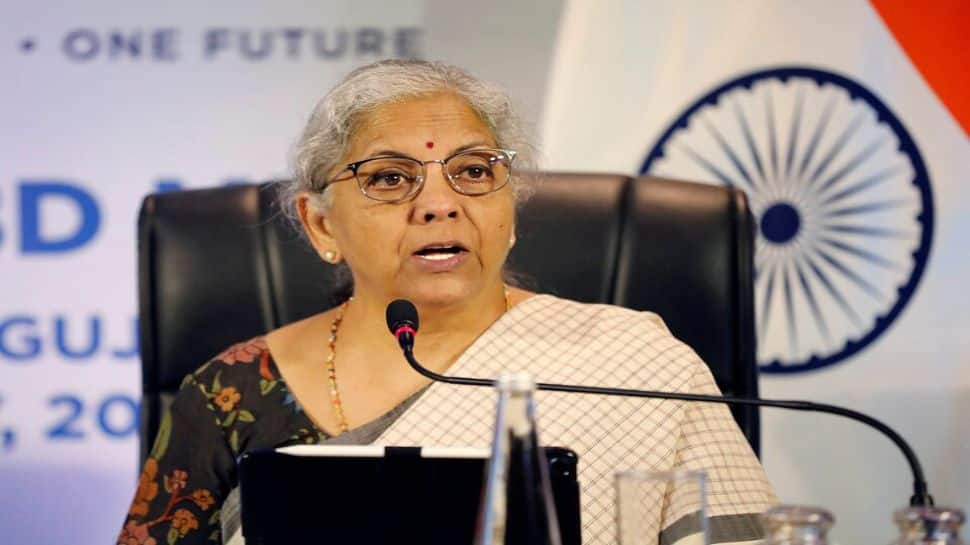
India’s Public Sector Banks Merger: The Centre is mulling over consolidating public-sector banks, and officials involved in the process say the long-term plan could eventually bring down the number of state-owned lenders from 12 to possibly just 4. The goal is to build a banking system that is large enough in scale, has deeper capital strength and is prepared to meet the credit needs of a fast-growing economy.
The minister explained that bigger banks are better equipped to support large-scale lending and long-term projects. “The country’s economy is moving rapidly toward the $5 trillion mark. The government is active in building bigger banks that can meet rising requirements,” she said.
Why India Wants Larger Banks
Sitharaman recently confirmed that the government and the Reserve Bank of India have already begun detailed conversations on another round of mergers. She said the focus is on creating “world-class” banks that can support India’s expanding industries, rising infrastructure investments and overall credit demand.
She clarified that this is not only about merging institutions. The government and RBI are working on strengthening the entire banking ecosystem so that banks grow naturally and operate in a stable environment.
According to her, the core aim is to build stronger, more efficient and globally competitive banks that can help sustain India’s growth momentum.
At present, the country has a total of 12 public sector banks: the State Bank of India (SBI), the Punjab National Bank (PNB), the Bank of Baroda, the Canara Bank, the Union Bank of India, the Bank of India, the Indian Bank, the Central Bank of India, the Indian Overseas Bank (IOB) and the UCO Bank.
What Happens To Employees After Merger?
Whenever bank mergers are discussed, employees become anxious. A merger does not only combine balance sheets; it also brings together different work cultures, internal systems and employee expectations.
In the 1990s and early 2000s, several mergers caused discomfort among staff, including dissatisfaction over new roles, delayed promotions and uncertainty about reporting structures. Some officers who were promoted before mergers found their seniority diluted afterward, which created further frustration.
The finance minister addressed the concerns, saying that the government and the RBI are working together on the merger plan. She stressed that earlier rounds of consolidation had been successful. She added that the country now needs large, global-quality banks “where every customer issue can be resolved”. The focus, she said, is firmly on building world-class institutions.
‘No Layoffs, No Branch Closures’
She made one point unambiguous: no employee will lose their job due to the upcoming merger phase. She said that mergers are part of a natural process of strengthening banks, and this will not affect job security.
She also assured that no branches will be closed and no bank will be shut down as part of the consolidation exercise.
India last carried out a major consolidation drive in 2019-20, reducing the number of public-sector banks from 21 to 12. That round improved the financial health of many lenders.
With the government preparing for the next phase, the goal is clear. India wants large and reliable banks that can support a rapidly growing economy and meet the needs of a country expanding faster than ever.
-

 Sports7 days ago
Sports7 days agoWATCH: Ronaldo scores spectacular bicycle kick
-

 Entertainment7 days ago
Entertainment7 days agoWelcome to Derry’ episode 5 delivers shocking twist
-

 Politics7 days ago
Politics7 days agoWashington and Kyiv Stress Any Peace Deal Must Fully Respect Ukraine’s Sovereignty
-

 Business1 week ago
Business1 week agoKey economic data and trends that will shape Rachel Reeves’ Budget
-

 Tech5 days ago
Tech5 days agoWake Up—the Best Black Friday Mattress Sales Are Here
-

 Fashion7 days ago
Fashion7 days agoCanada’s Lululemon unveils team Canada kit for Milano Cortina 2026
-

 Tech5 days ago
Tech5 days agoThe Alienware Aurora Gaming Desktop Punches Above Its Weight
-

 Politics1 week ago
Politics1 week ago53,000 Sikhs vote in Ottawa Khalistan Referendum amid Carney-Modi trade talks scrutiny





